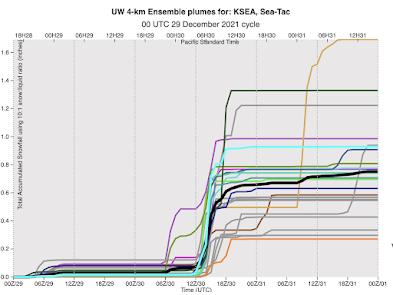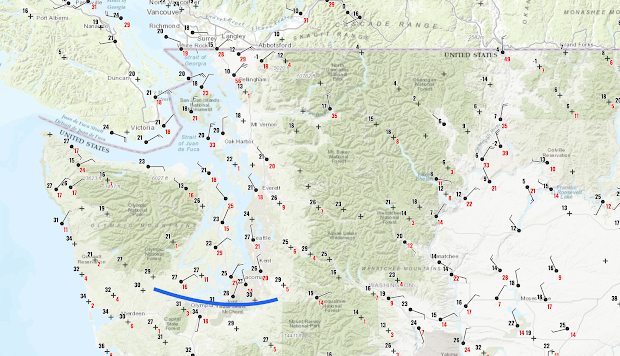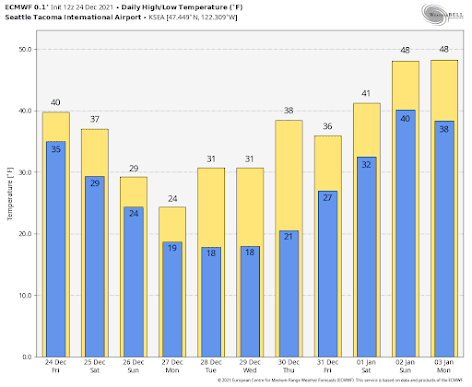Today is sunny, but cool, with temperatures in the teens across eastern Washington and in the lower to mid-30s in the west. Viewed from the space, the state is mostly covered in snow (see below).
This blog discusses current weather, weather prediction, climate issues, and current events
December 31, 2021
New Podcast: The Weekend Weather and the Colorado Wildfire
December 30, 2021
A New Weather Concern: The Slush Freeze
The event last night played out similar to predicted. For most locations in western Washington, a few inches of wet snow fell and temperatures rose just above freezing.
We have had a remarkably cold period in many ways. It was the first time since 1998 that Seattle remained below freezing for three days in a row. Many locations fell below daily low-temperature records. And Vancouver, Canada at 4.5F had their coldest temperature in 50 years.
The winds and temperatures coming out of the Fraser River valley during this event were historic.
But something interesting (and threatening) could happen tonight and Friday night....a slush freeze...as cold temperatures temporarily return to the region.
Washington DOT and Seattle DOT need to be aware of it.
December 29, 2021
A Difficult Snow Forecast--As True of Most Western Washington Snow Events
Forecasting snow in western Washington is very difficult, even with modern prediction tools.
Before high-resolution models and satellite observations over the Pacific, it was nearly impossible to accurately predict local snow events and major local snowstorms occurred with little warning (for example, December 18, 1990).
Consider:
1. There is roughly a one to ten ratio between precipitation totals (amount of water falling from the sky) and snow totals, so a small error in precipitation amounts results in huge snowfall errors. Making a 0.10 error in precipitation provides a 1-inch error in snowfall.
2. Temperatures over the western lowlands are often marginal for snow. Right on the edge. So small temperature errors can produce huge changes in snowfall. Same with small changes in elevation or distance from the warm water.
3. There are huge local differences in precipitation because of our local terrain, such as rainshadows, convergence zones, gaps winds, and more. Plus, our complex land-water contrasts.
It ain't Kansas around here. And forecasting snow in Kansas is a piece of cake compared to our challenges.
The snow forecast tomorrow has all of these elements, with the snow mainly between midnight and 10 AM,
Here is the snowfall total for the period through 2PM Thursday. Healthy totals in the mountains. Little on the coast and the Strait where temperatures will be too warm. Less in the lee of the Olympics mainly because of snow shadowing in the lee of the Olympics. And temperatures will be on the edge for the southern Sound (yes--Puget Sound will see temperatures rise above freezing tomorrow late morning and afternoon)
December 28, 2021
A Snow-Shadow Snow Event
You have all heard of a rainshadow.
Air approaching a barrier rises on the windward side, producing lots of precipitation, while air sinks on the lee side, causing drying and a lack of rain (see graphic).
On Thursday, we are going to have a profound snow-shadow situation for large portions of the western Washington lowlands, particularly around Puget Sound, and snow lovers like myself are going to be disappointed.
Below is the latest super-high resolution UW snowfall forecasts for the 24-h ending 4 AM Friday morning. Light green is less than an inch, while purples and darker colors indicate more than 6 inches.
Plenty of snow on the windward (western) sides of the Olympics and Cascades. Bellingham is going to be snowed in! But little around Puget Sound and virtually nothing from north Seattle to north Kitsap. No snow near Yakima on the eastern side of the Cascades.
So why so little snow around Puget Sound? The problem will not be the temperature--it will be cold enough to snow. The problem will be a lack of precipitation.
And that deficiency is due to the orientation of the winds in the lower atmosphere, which will be from the northwest, resulting in downward flow on the lee side of the Olympics.
December 27, 2021
Why Does Western Washington Have Some of the Worst Roadway Icing in the Country? And the Next Snowstorm in Sight
Western Washington can brag about world-class coffee and leading corporations, but did you know we also have some of the worst road icing conditions in the nation when we get some snow?
Icing so bad that mayors can lose their jobs when they forget this meteorological fact?
Icing that can cripple parts of Seattle, killing and injuring both drivers and pedestrians?
It happened again last night and today. Let me tell you why.
Western Washington has a mild winter climate and our soils and roads cool down in autumn, of course, but remain well above freezing during the winter.
Then we get a snow event, with several inches falling on the roadways. This snow starts to melt into a slush layer.
Next, much colder air comes in, as the low center and upper trough that produced the snow moves out. The air temperatures become cold enough that the slush layer begins to freeze...and if cold enough (like yesterday today), it freezes solid to the roadway surface (and almost impossible to remove at this point).
The only way to stop this is to pretreat all roadways with a deicer (such as salt or potassium chloride) BEFORE the show falls and to remove snow after it falls, but before it freezes. Judging from driving around Seattle today, not enough of both were done. Many of the city's major roadways are not in good shape.
Another interesting aspect of this event has been the terrific steam fog produced over the Sound and other local water bodies. When very cold air passes over relatively warm water, you can get tendrils of steam fog.
To illustrate, take a look at a video shot from the north side of the Kitsap Peninsula by Greg Johnson of Skunk Bay Weather.
Here is the European Center 24-h snowfall ending 4 PM Thursday. 4-5 inches over Seattle.
December 26, 2021
The Arctic Front Arrives Bringing Lowland Snow and Dangerous Windchill
Update: Here are the latest storm totals from the National Weather Service. Heavy snow near Port Angeles (10-15 inches) and 1.5 to 5 inches around Puget Sound.
_____________________
As predicted, the cold air pushed into western Washington, with the arctic front on the leading edge, with highly variable snow depths reported at 7 AM this morning (see Cocorahs snow map below).
Cold air entered Bellingham yesterday leading to lots of snow (4-15 inches reported), and as the cold air pushed southwestward later yesterday, the northern Olympic Peninsula area areas (e.g., Sequim to Port Angeles) got hit hard, with up to around a foot of snow.
Over Puget Sound, most of the snow action was with the arctic front this morning, with 3-5 inches being reported. The radar image at 7:37 AM this morning clearly showed the intense arctic front snowband (yellow colors) pushing southward. The high-resolution models got this feature essentially correct.
The current observations show tremendous temperature and wind variability across the region (see surface map at 10 AM, click on I'm age to expand). The leading edge of the arctic front is now (11 AM) around Olympia (blue line), with northerly flow behind it and southerly flow in front of it. The convergence of air into this feature causes upward motion and precipitation.
December 25, 2021
Weather Showtime is Approaching--- And a More Threatening Snow Situation Reveals Itself
Some light snow has fallen around Bellingham and environs in the Fraser River outflow (see below), and modest snow has also fallen to the southeast of the Olympics over portions of the Kitsap Peninsula. Snow has whitened the region above roughly 1000ft, and heavy snow continues to fall in the mountains.
But the real action is ahead, both in cold and snow, and it appears that we have a shot of more extensive lowland snow on Thursday.
The Cold
A modified Arctic front will move through Puget Sound around midnight. Temperatures will plummet with its passage, which will also be accompanied by a dramatic shift in wind direction to the north. Cold air has already started to pour through the Fraser River gap into Northwest Washington, with temperatures dropping into the mid to low 30s, borne by strong northeasterly winds (see map for 11 AM, red numbers are gusts in mph).
The forecasts are now consistent and reliable.... western Washington will experience temperatures dropping to the lower to mid-teens, while eastern Washington will get the full arctic treatment, with highs in the single digits and lows below zero (see European Center temperature forecasts below)
Sea level pressure (solid lines, and 800-meter temperatures, colors)--brown and purple are the coldest temperatures.
Finally, the big lowland snow threat in the future. On Thursday, cold air will be in place and a Pacific front will approach, resulting in precipitation (snow). The 24-h snowfall ending 4 AM Friday is much more significant for central Puget Sound. More on this as we get closer.
December 24, 2021
The Cold/Snow Forecast is Now Much Clearer
I will have a Snow Update at Noon (Dec. 25th)
_____________________________________
As we get closer to an event, very powerful tools become available to meteorologists: high-resolution model predictions, high-resolution ensembles of many forecasts, the NOAA/NWS HRRR model, to name only a few.
And forecast skill obviously improves as we get closer to the event.
So based on all this technology, and decades of experience in predicting Northwest snow, let me provide you with the latest update.
The temperatures are too warm for snow over the lowlands today, with the current freezing level approximately 2300 ft. The snow level (the level at which all snow is melted) is about 1000 ft lower (1300 ft).
Near-surface temperatures will remain above freezing throughout the night and Saturday morning/early afternoon. Temperatures will be a bit colder around Bellingham as cold Fraser River air starts to move in.
But around 4 PM tomorrow (Dec. 25th), all hell will break loose as Arctic air pushes energetically through the Fraser River Valley into NW Washington. Temperatures will rapidly fall below freezing in western Washington, with gusty winds from the north. Arctic air will also push south into eastern Washington.
Trust me...you will know this is happening....the equivalent to being hit by a meteorological sledgehammer.
Here are the daily high/low predictions from the European Center model for Seattle. By Monday, a high of 24 and a low of 19F, with the lows cooling a bit the next few days, followed by warming at the end of the month.
Spokane (and eastern WA) will be much cooler, with highs in the teens, and lows falling below zero.
The UW high-resolution ensemble system, with the WRF model run many times with small differences in its starting point and physics, is a powerful tool for looking at uncertainty. Below are the forecast temperatures at SeaTac, time is on the x-axis and 00Z/26 is tomorrow at 4PM.
But the predicted snow DEPTH on Monday morning at 4 AM, after another 24 h of scattered showers, is unimpressive. Yes, the ground will be white around Puget Sound, but generally less than .06 meters (about 2.5 inches). Not big snowfall that kids (both young and old look for).
December 23, 2021
Most Will Have to Dream of a White Christmas
Detailed update this afternoon....I will have the forecasts from the more powerful high-resolution forecast models by then....
___________________________
I have some disappointing news for many living over the western Washington lowlands.
Saturday, December will not bring extensive lowland snow on the ground.
On the other hand, many of you will enjoy seeing snowflakes falling out of the sky, which coupled with a rendition of Irving Berlin's classic music and some hot chocolate, might be enough.
Large amounts of snow are expected in the mountains, so snow recreation will be excellent and close.
Snow 101
The temperatures during the next few days will be marginal for snow near sea level, which is often the case in our region.
In addition, the ground temperatures are relatively warm, as illustrated by the current soil temperatures from the WSU AgWeather network, which are in the low 40s in the west and mid to upper 30s over the Columbia Basin (see below).
The distinction between snowfall (amount of snow falling out of the sky) and snow depth is an important one, with snow depth often being MUCH less than snowfall.
But now let me show you the snow accumulation (snow depth) on the ground over western Washington predicted by the same modeling system for the same period.
Skillful Weather Warnings But Catastrophic Damage and Large Death Tolls. We Need to Do Better.
The same tragedy has happened time and again. An excellent prediction of a major weather-related threat is unheeded, leading to massive des...

-
The latest model forecasts are consistent: an unusually powerful storm with extreme low pressure will develop rapidly offshore on Monday a...
-
An extraordinary storm will develop a few hundred miles off our coast on Tuesday, a storm every bit as strong as a Category 1 hurricane. B...




















































